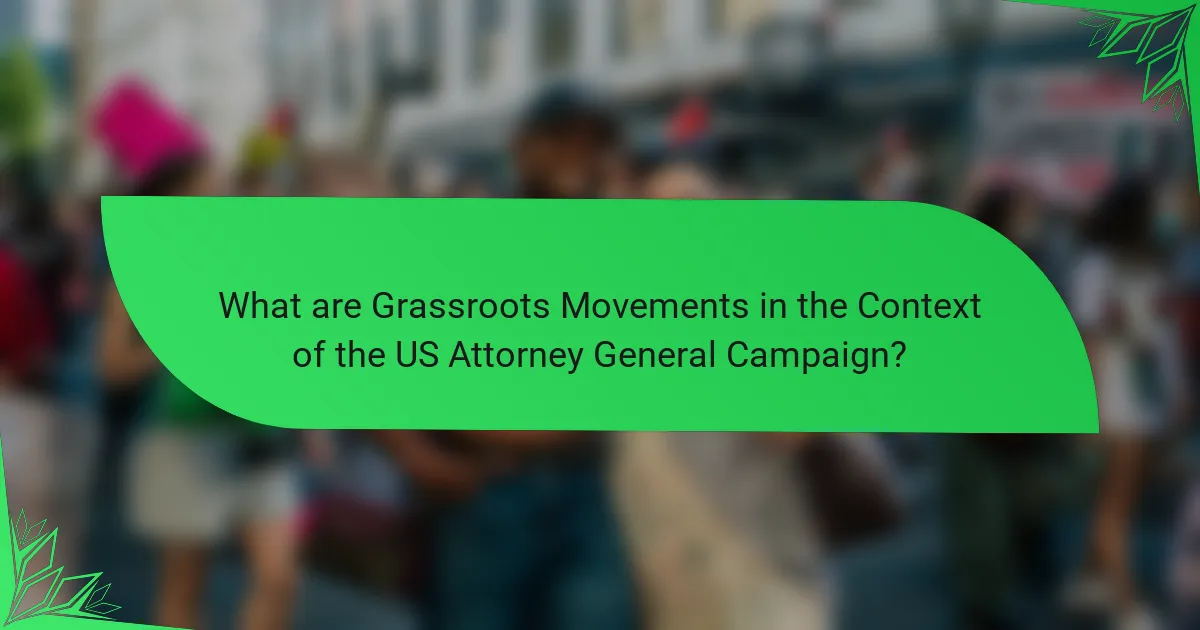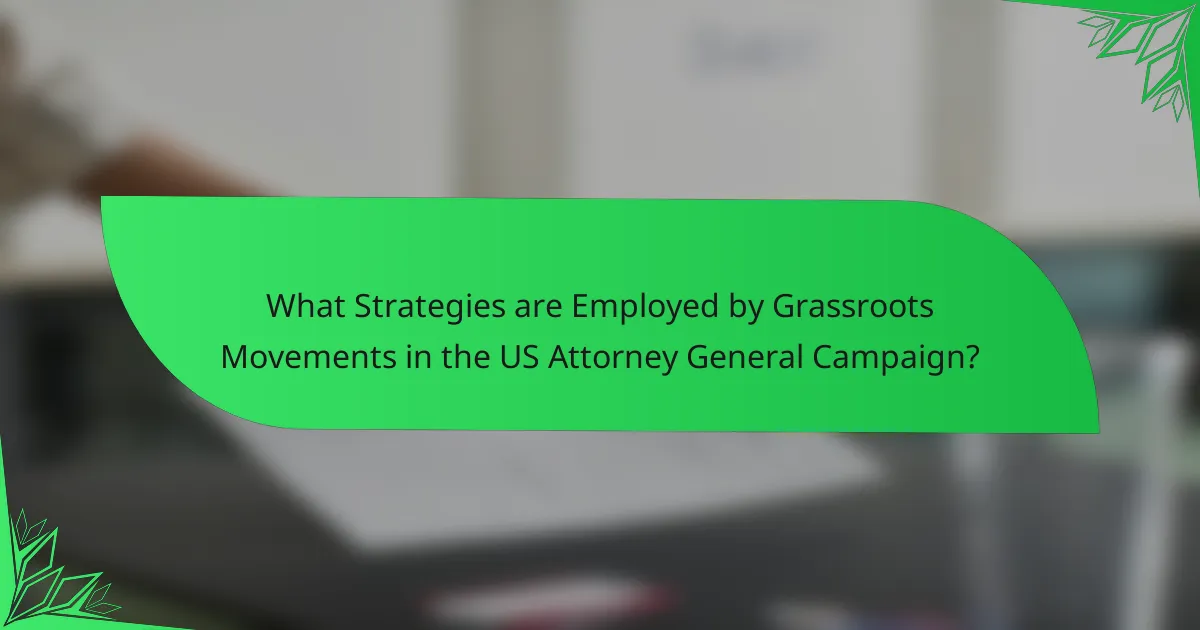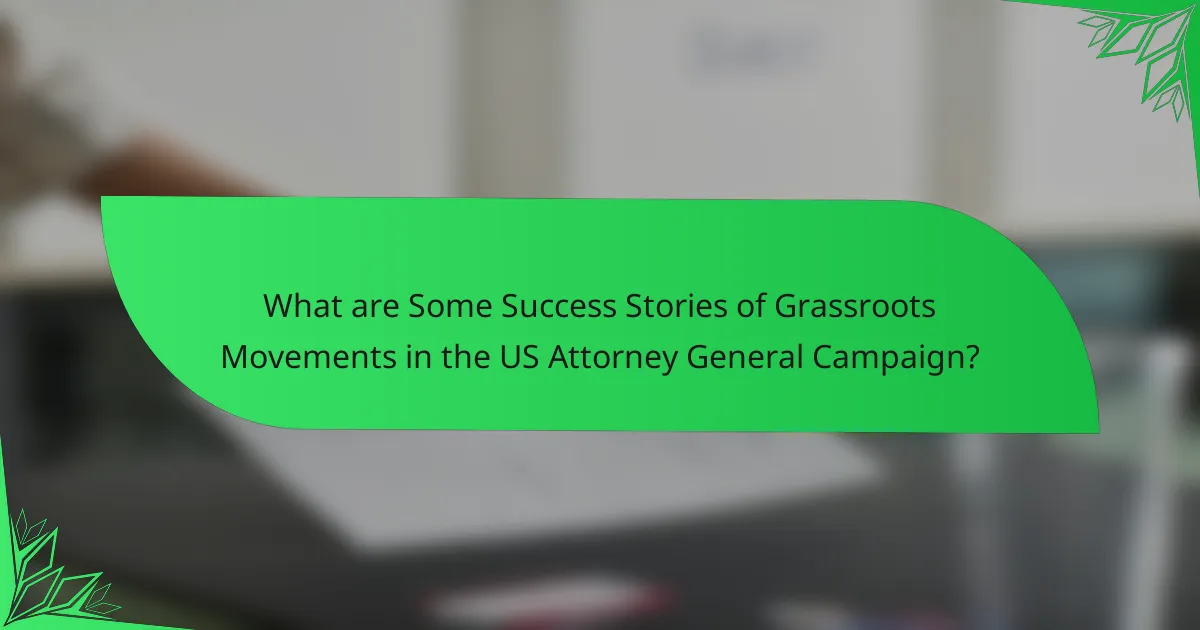Grassroots movements are community-driven initiatives aimed at influencing legal and political change within the context of the US Attorney General campaigns. These movements engage ordinary citizens to advocate for critical issues, including criminal justice reform and consumer protection, utilizing strategies such as community organizing, digital mobilization, and coalition building. Historical examples highlight the success of grassroots efforts, such as Letitia James in New York and Maura Healey in Massachusetts, demonstrating their ability to significantly impact election outcomes and foster community engagement. This article explores the strategies, successes, and implications of grassroots movements in shaping the landscape of the US Attorney General campaigns.

What are Grassroots Movements in the Context of the US Attorney General Campaign?
Grassroots movements in the context of the US Attorney General campaign are community-driven efforts aimed at influencing legal and political change. These movements mobilize ordinary citizens to advocate for specific issues, such as criminal justice reform or consumer protection. They often rely on local organizing, volunteer efforts, and social media to raise awareness and build support. Grassroots campaigns can significantly impact election outcomes by engaging voters and shaping public discourse. Historical examples include the campaigns that led to the election of progressive attorneys general focused on reforming the justice system. These movements demonstrate the power of collective action in the political arena.
How do Grassroots Movements influence political campaigns?
Grassroots movements significantly influence political campaigns by mobilizing community support and shaping public discourse. They engage local populations through door-to-door canvassing, rallies, and social media outreach. This engagement often leads to increased voter turnout, especially among young and first-time voters. For instance, the 2008 Obama campaign utilized grassroots strategies effectively, resulting in a record voter turnout. Additionally, grassroots movements can pressure candidates to adopt specific policies that reflect community needs. They also foster a sense of ownership among constituents, making them more invested in the electoral process. Research shows that campaigns with strong grassroots support tend to have higher success rates in elections.
What are the key characteristics of effective Grassroots Movements?
Effective grassroots movements are characterized by strong community engagement, clear goals, and inclusive participation. They mobilize local support to address specific issues. Effective communication strategies are essential for raising awareness. Leadership is often decentralized, empowering individuals at various levels. Grassroots movements leverage social media for outreach and organization. They build coalitions with other organizations to amplify their impact. Successful movements demonstrate adaptability to changing circumstances. Historical examples, such as the Civil Rights Movement, showcase these characteristics in action.
How do community engagement and mobilization play a role?
Community engagement and mobilization are vital in grassroots movements. They foster public participation and build collective action. Engaged communities are more likely to advocate for change. Mobilization transforms individual concerns into a unified voice. This process enhances the visibility of issues in political campaigns. For example, community-led initiatives can influence policy decisions. Research shows that active community involvement increases voter turnout. According to a study by the Pew Research Center, communities with strong engagement see 20% higher participation in elections. This demonstrates the powerful impact of mobilization on democratic processes.
Why are Grassroots Movements important for the US Attorney General Campaign?
Grassroots movements are crucial for the US Attorney General campaign because they mobilize community support and engagement. These movements foster a sense of ownership among constituents. They amplify local voices and issues that may be overlooked by traditional campaigns. Grassroots efforts often lead to increased voter turnout, which is essential for electoral success. Research shows that campaigns with strong grassroots support can significantly influence election outcomes. For example, the 2020 elections highlighted how grassroots organizing helped candidates connect with voters on a personal level. This connection can lead to more informed and motivated voters. Ultimately, grassroots movements are vital as they build a strong foundation for campaign strategies and enhance democratic participation.
What impact do they have on voter turnout and awareness?
Grassroots movements significantly increase voter turnout and awareness. They mobilize communities through local engagement and targeted outreach. For instance, studies show that grassroots campaigns can raise voter participation by up to 20%. These movements often utilize door-to-door canvassing and social media to inform potential voters. By focusing on local issues, they create a sense of urgency and relevance. Additionally, grassroots efforts educate voters about the electoral process and candidates. This education fosters informed decision-making among constituents. Overall, grassroots movements play a crucial role in enhancing democratic participation.
How do they shape public policy and legal reform?
Grassroots movements shape public policy and legal reform by mobilizing community members and advocating for change. They raise awareness about specific issues, influencing public opinion and policy agendas. Through organized campaigns, these movements often pressure lawmakers to enact reforms. For instance, the Civil Rights Movement led to significant legislative changes in the 1960s. Grassroots efforts also provide a platform for marginalized voices, ensuring their concerns are addressed. By leveraging social media and community organizing, these movements can rapidly disseminate information and rally support. Ultimately, their persistent advocacy can lead to substantial shifts in legislation and policy implementation.

What Strategies are Employed by Grassroots Movements in the US Attorney General Campaign?
Grassroots movements in the US Attorney General campaign employ strategies such as community organizing, digital mobilization, and coalition building. Community organizing involves engaging local residents to advocate for justice-related issues. Digital mobilization utilizes social media platforms to spread awareness and gather support. Coalition building fosters partnerships with other organizations to amplify their message. These strategies enhance voter engagement and increase visibility for candidates. Research shows that grassroots campaigns can significantly influence election outcomes, particularly in local races.
How do Grassroots Movements organize their campaigns?
Grassroots movements organize their campaigns by mobilizing community members around shared goals. They typically begin with identifying a specific issue or concern relevant to their community. Next, they gather supporters through meetings, social media, and outreach efforts. Campaigns often involve creating a clear message that resonates with the community. Organizers develop strategies that include petitions, rallies, and educational events to raise awareness. They also collaborate with local organizations to amplify their efforts. Funding is often sourced from community donations and small grants. Successful grassroots campaigns have historically led to significant policy changes, demonstrating their effectiveness in influencing decision-makers.
What tools and platforms are commonly used for mobilization?
Commonly used tools and platforms for mobilization include social media, email campaigns, and mobile messaging apps. Social media platforms like Facebook and Twitter facilitate outreach and engagement with supporters. Email campaigns allow organizations to communicate directly with constituents and share important updates. Mobile messaging apps, such as WhatsApp, enable quick communication and coordination among team members. Additionally, online petition platforms help gather support and demonstrate public interest. These tools enhance the ability to mobilize communities effectively in grassroots movements.
How do they build coalitions and partnerships?
They build coalitions and partnerships through strategic outreach and collaboration. Grassroots movements identify shared goals among diverse groups. They engage community members to foster trust and inclusivity. Regular meetings facilitate open communication and idea sharing. Utilizing social media amplifies outreach efforts and connects stakeholders. They leverage existing networks to expand their influence. Successful coalitions often include various organizations and community leaders. These partnerships enhance resources and collective impact on campaigns.
What challenges do Grassroots Movements face in the US Attorney General Campaign?
Grassroots movements face significant challenges in the US Attorney General campaign. Limited funding restricts their ability to compete with well-funded opponents. Additionally, lack of media coverage hampers their visibility and outreach efforts. Voter apathy can undermine grassroots initiatives, making it difficult to mobilize support. Complex legal and regulatory frameworks can complicate campaign strategies. Furthermore, internal divisions may weaken their effectiveness and message coherence. Lastly, established political networks often resist grassroots efforts, creating barriers to entry.
How do funding and resources affect their effectiveness?
Funding and resources significantly enhance the effectiveness of grassroots movements. Adequate funding allows for better outreach, organizing events, and mobilizing community members. Resources such as training materials and technology improve campaign strategies. Research shows that movements with substantial financial backing can reach larger audiences and have a greater impact. For instance, the 2018 midterm elections saw increased funding for grassroots campaigns leading to higher voter turnout. This correlation indicates that financial support is crucial for success. Ultimately, effective grassroots movements rely on sufficient funding and resources to drive their initiatives forward.
What legal or political obstacles do they encounter?
Grassroots movements encounter various legal and political obstacles during their campaigns. These obstacles include restrictive campaign finance laws that limit fundraising efforts. Additionally, they face challenges related to ballot access requirements, which can hinder their ability to get candidates on the ballot. Local and state regulations may impose restrictions on organizing public demonstrations or rallies. Moreover, grassroots movements often contend with opposition from established political entities, which can lead to legal disputes. These factors can significantly impede their effectiveness and outreach efforts in the political landscape.

What are Some Success Stories of Grassroots Movements in the US Attorney General Campaign?
Grassroots movements have significantly influenced US Attorney General campaigns. One notable success is the 2018 campaign of Letitia James in New York. She became the first African American woman elected as Attorney General in the state. Her campaign focused on issues like social justice and corporate accountability.
Another example is the campaign of Maura Healey in Massachusetts. Healey gained attention for her work on consumer protection and civil rights. Her grassroots support helped her secure a second term in 2022.
In California, Xavier Becerra’s campaign in 2018 emphasized immigrant rights and healthcare. His grassroots efforts mobilized diverse communities, contributing to his victory.
These examples demonstrate how grassroots movements can drive change in the Attorney General landscape by fostering community engagement and addressing local issues.
What notable Grassroots Movements have made a significant impact?
Notable grassroots movements that have made a significant impact include the Civil Rights Movement, the Women’s Suffrage Movement, and the Environmental Justice Movement. The Civil Rights Movement sought to end racial segregation and discrimination against African Americans. It led to landmark legislation like the Civil Rights Act of 1964. The Women’s Suffrage Movement fought for women’s voting rights, culminating in the 19th Amendment in 1920. The Environmental Justice Movement addresses environmental inequalities faced by marginalized communities. It has influenced policies and raised awareness about pollution and health disparities. Each of these movements mobilized communities, utilized strategic advocacy, and achieved substantial legislative and social changes.
How did they achieve their objectives?
Grassroots movements achieved their objectives through community mobilization and strategic engagement. They organized local events to raise awareness and build support. These movements utilized social media to amplify their message and reach wider audiences. Volunteers were recruited to engage with community members directly. They formed coalitions with other organizations to strengthen their efforts. Fundraising initiatives provided necessary resources for campaigns. Targeted messaging addressed specific community concerns, making their objectives relatable. Data-driven approaches helped track progress and adapt strategies effectively.
What lessons can be learned from their success?
Grassroots movements demonstrate the power of community engagement in political campaigns. Successful campaigns often leverage local networks to mobilize support. Building trust within communities fosters stronger relationships and commitment. Effective communication strategies resonate with diverse audiences. Utilizing social media amplifies outreach and engagement efforts. Persistent advocacy leads to sustained interest and involvement. Collaboration with local organizations enhances resource sharing and impact. These lessons highlight the importance of grassroots strategies in achieving political success.
How can communities effectively engage in Grassroots Movements for the US Attorney General Campaign?
Communities can effectively engage in grassroots movements for the US Attorney General campaign by organizing local events and rallies. These activities raise awareness and mobilize support. Utilizing social media platforms can amplify their message and reach a broader audience. Collaborating with local organizations strengthens community ties and resources. Engaging in door-to-door canvassing allows for personal connections with voters. Hosting informational sessions educates the public on key issues and candidates. Collecting signatures for petitions demonstrates grassroots support. These strategies have historically increased voter turnout and community involvement in political campaigns.
What best practices should community members follow?
Community members should engage in open communication and active participation. They must attend meetings to voice concerns and share ideas. Collaborating with local organizations enhances community efforts. Members should educate themselves about issues affecting their community. Volunteering for initiatives fosters a sense of belonging. Respecting diverse opinions promotes a healthy dialogue. Utilizing social media effectively can amplify community messages. Following these practices strengthens grassroots movements and increases impact.
How can individuals contribute to the success of these movements?
Individuals can contribute to the success of grassroots movements by actively participating in community organizing. This involvement includes attending meetings, rallies, and events to show support. Engaging in discussions helps to spread awareness and educate others about the movement’s goals. Volunteering time and skills for campaign activities directly impacts effectiveness. Donating resources, whether financial or material, provides necessary support for initiatives. Utilizing social media platforms amplifies the movement’s message and reaches a broader audience. Collaborating with local organizations enhances collective efforts and strengthens community ties. Research shows that grassroots movements with strong community involvement have higher success rates in achieving their objectives.
Grassroots movements are community-driven initiatives aimed at influencing political and legal change, particularly in the context of the US Attorney General campaign. This article explores how these movements mobilize citizens to advocate for issues such as criminal justice reform, consumer protection, and voter engagement. Key characteristics of effective grassroots movements, their strategies for organizing campaigns, and notable success stories are highlighted, demonstrating their significant impact on voter turnout and public policy. Additionally, the article addresses the challenges faced by these movements, including funding limitations and legal obstacles, while offering insights into best practices for community involvement.
